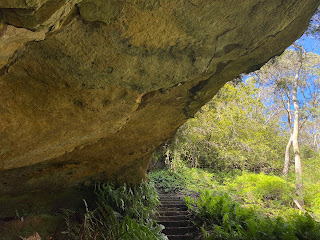Next stop - the Blue Mountains. Considered part of the western outskirts of the Greater Sydney area, the foothills of the Blue Mountains start about 50 kms west of the city. The Blue Mountains form a part of the extensive mountainous area, the Great Dividing Range. Following European settlement of the Sydney area, the mountains were named the Carmarthen and Lansdowne Hills, but the name Blue Mountains was preferred and is derived from the blue tinge the range takes on when viewed from a distance. (For the science-minded, this blue tinge is likely caused by volatile terpenoids emitted in large quantities by the abundant eucalyptus tress, which cause Mie scattering and thus the blue haze.)
There are a few small communities dotted along the highway that passes through the Blue Mountains, and I was fortunate to have friends who live in one of these, a little town called Leura. Leura has a population of just over 4500, is the second most westerly community away from Sydney, and if you ask the locals, is arguably the prettiest community in the Blue Mountains. As I didn’t have all that long here (only three days), my preference however was to visit the scenic lookouts and do a bit of hiking, so I really didn’t see much of the town. That’s okay - always nice to have something for the next time.
It was a bit overcast today but still the mountains, and valleys, looked spectacular!
Banksia is a genus of around 170 species of flowering plants in the family Proteaceae. These Australian wildflowers are easily recognized by their characteristic flower spikes and woody fruiting “cones” and heads. Heavy producers of nectar, banksias are a vital part of the food chain in the Australian bush. They are an important food source for nectarivorous animals, including birds, bats, rats, possums, stingless bees an a host of invertebrates.
A Saw Banksia - don’t know if the leaves could actually cut or not, but they sure look like they could!
Hairpin Banksia
Not a lot of water in it right now, but Wentworth Falls plunges over 100 metres to the valley floor.
Mountain Devil
This is an ancient landscape and the view would have looked very similar 6 million years ago. Perched 500 metres above the valley floor, the view offers a spectacular overlook of the Greater Blue Mountains World Heritage area - sheer sandstone cliffs, talus slopes and deep clefts worn by creeks and rivers through the soft sandstone over eons in time. This country has been the spiritual home of the Darug and Gundungurra peoples for at least 20,000 years and there are many stories associated with the land and its people.


The Three Sisters are an unusual rock formations, and one of the Blue Mountains’ best known sites. Their names are Meehni (922m), Wimlah (918m) and Gunnedoo (906m). The commonly told legend of the Three Sisters is that three sisters, Wimalah, Meeni, and Gunedoo lived in the Jamison Valley as members of the Katoomba tribe. They fell in love with three men from the neighbouring Nepean tribe, but marriage was forbidden by tribal law. The brothers were not happy to accept this law and so decide to capture the three sisters. A major tribal battle ensued, and the sisters were turned to stone by en elder to protect them, but the elder was killed in the fighting and no one else could turn them back.
A New South Wales Waratah
Another day and this time a bright blue sky, and more lookouts out over the Blue Mountains.
Another kookaburra in a gum tree!
Crimson Flag
One of many walking tracks, this one follows beside a little stream to reach the Pool of Siloam, where a waterfall pours into a cool rocky glade.
Pool of Siloam
The track also takes you to deep sandstone caves which were once used as shelter by Aborginal people.
As I said, I didn’t see much of the town but I did spot this lovely little mural with “Greetings from Leura”.


































No comments:
Post a Comment